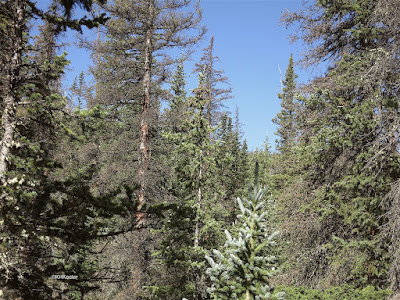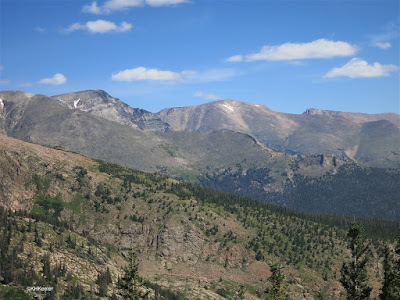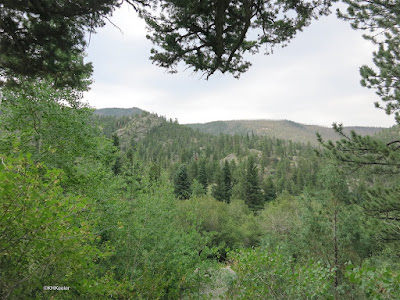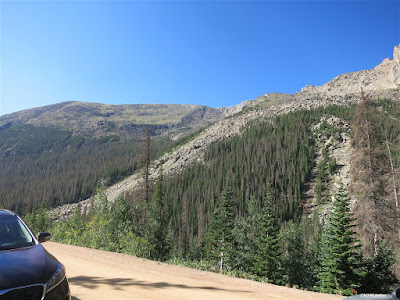 |
| Almost to the top of Old Fall River Road |
Long vehicles are discouraged. We were a bit concerned about taking a Prius but in fact having a compact car made the turns, some truly hair-pin, easier for us than for bigger vehicles. Had it been after a heavy rain, we might have regretted the Prius: there were muddy ruts in the road, some quite deep, but when we were there, dry and easily avoided.
So on a sunny morning we headed up Old Fall River Road.
There's a helpful brochure you can purchase at the base of the climb which points out highlights and is careful to warn you about steep grades, no guardrails and other hazards.
Speed limit: 15. Road length: 9 miles. Elevation gain: 3,280 feet, to 11,796 feet above sea level.
We were pleased to find some wide spots to hop out.
I wasn't thinking of writing about it the time, so I don't have pictures looking forward or back along the road. It was just a dirt road, occasionally with ruts to avoid.
 |
| Subalpine forest |
All kinds of neat things were flowering under the trees in the subalpine (we didn't stop much below that).
This small goldenrod (probably the Rocky Mountain goldenrod, Solidago multiradiata) was only about 6" high, growing near or under the trees in the subalpine.
And there was this pretty little cinquefoil (genus Potentilla, rose family, Rosaceae). I don't know which species: Colorado has 30 species, most of them small with yellow flowers.
Then the road climbed some more, the forest fell away, and we drove through alpine tundra. An elevation too cold, frozen too much of the year, for trees. In my picture below, there is a big patch that is a knee-high fir tree. Trees keep trying to grow in the tundra. Warming will let them grow better but it won't be uniform: decent-sized trees will grow in sun-warmed areas, the exposed or deeply shaded spots will likely be tree-free for a long time.
 |
| Alpine tundra, dwarfed trees in the middle distance. The pole will be put back in the ground before fall, to mark the road when the snow is deep. |
The above is clearly a composite, aster family, Asteraceae. Perhaps it is Senecio amplectans, showy alpine ragwort.
Below is elephant's head, Pedicularis groenlandica (broomrape family, Orobachaceae). There are many species of Pedicularis in Colorado, most called louseworts. This one, if I have the id right, is found clear to Greenland, as the scientific name imples, widely distributed at high elevations or in the far north.
 |
| elephant head, Pedicularis groenlandica |
 |
| Alpine Visitor Center from Old Fall River Road |
One last look at alpine tundra plants. The purple is Whipple's penstemon, Penstemon whippleanus (plant family Plantaginaceae, plantain family) found from the montane zone up to the tundra, but varying in flower color (creamy yellow, white, lavender, maroon, blue, black-purple and violet: what's with that?!)
We took Trail Ridge Road down and, having packed a picnic, stopped for a scenic lunch when we found an open picnic table.
Photo from the drive down Trail Ridge Road:
 |
| Along Trail Ridge Road |
Comments and corrections welcome.
Check out the description on Rocky Mountain National Park's home page: link
I have the Colorado Rocky Mountain Wildflowers App link on my iPhone--very useful, especially because despite having half a dozen wildflower guides for Rocky Mountain National Park, half the time, like this time, I don't remember to grab one.
Plant naming is rapidly changing. I used J. Ackerfield. 2015. Flora of Colorado. BRIT Press, Fort Worth Texas.
Kathy Keeler, A Wandering Botanist
More at awanderingbotanist.com
Join me on Facebook: https://www.facebook.com/AWanderingBotanist










No comments:
Post a Comment